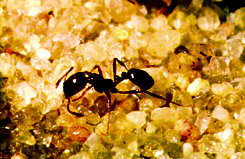After about 500 years, the identity of the insects that brought a kidney to some of the first Spanish settlements in the New World becomes clear
Carl Zimmer New York Times

Tropical fire ant. Entire estates have disappeared. Photo: Neil Reimer, Hawaii Department of Agriculture
Direct link to this page: https://www.hayadan.org.il/fireants170105.html
Dr. Edward Wilson, an entomologist from Harvard, believes he has solved a 487-year-old ecological mystery.
In 1518, an ant epidemic of enormous proportions consumed some of the first Spanish settlements in the New World, on the island of Hispaniola. The Spanish priest and historian Bartolome de las Casas recorded how entire estates of plantations were wiped off the face of the earth "as if fire sent from heaven and burned them." But despite the extent of the destruction, the identity of the plague ports was never discovered.
Wilson, an ant expert, enlisted historians to help him unravel the mystery. He used details from contemporary reports to narrow down the possible range of species. Two prominent clues were the painful sting of the ants and their habit of settling among the roots of plants. Only one species currently found in Hispaniola fits Wilson's description - the fire ant, Solenopsis geminata.
But fire ants do not eat plants. As Wilson points out, much of its diet comes from insects that feed on plant sap (the liquid inside the plant), such as mealybugs and soft aphids. These insects emit water saturated with sugar and amino acids, and the ants drink this water. They in turn protect the sap mammals from predators, while using their painful sting.
Wilson suspects that the plagues of 1518 happened after the Spanish settlers brought new species of sap mammals to Hispaniola. "The Spanish did not notice the connection between the things," said Wilson, who published his findings in the journal "Nature". "Their attention was given to the stings of the ants every time they touched the plant."
Wilson cautions, however, that so far it is only a reasonable suspicion regarding the identity of the species responsible for the ant epidemics. "I have enough material for conviction," he said, "I am ready to testify before a jury."
https://www.hayadan.org.il/BuildaGate4/general2/data_card.php?Cat=~~~58114086~~~162&SiteName=hayadan
